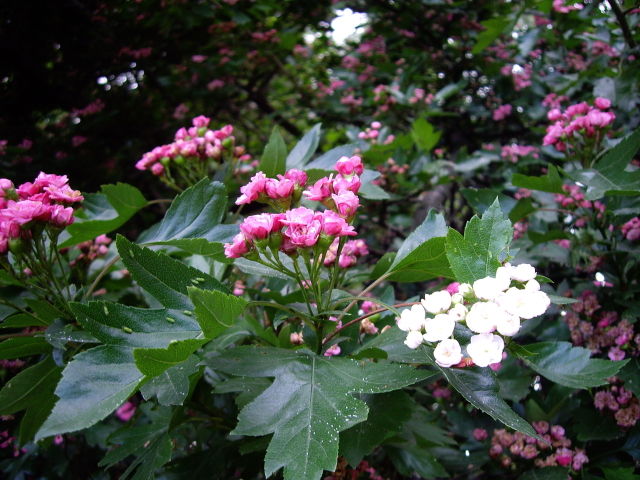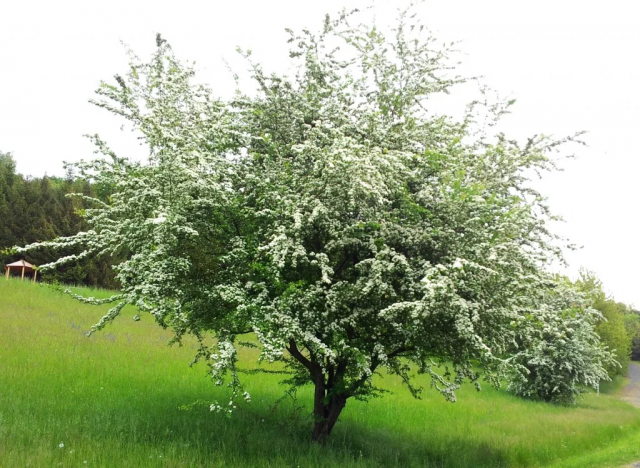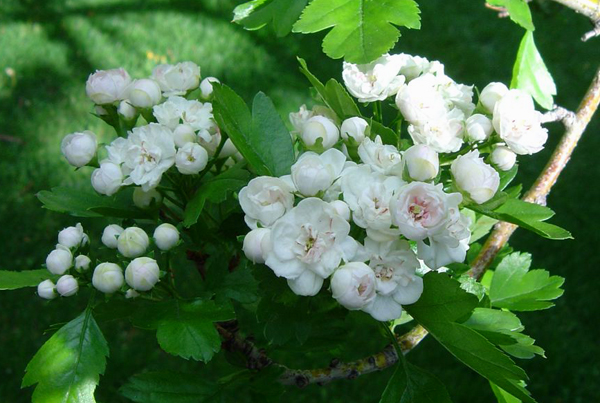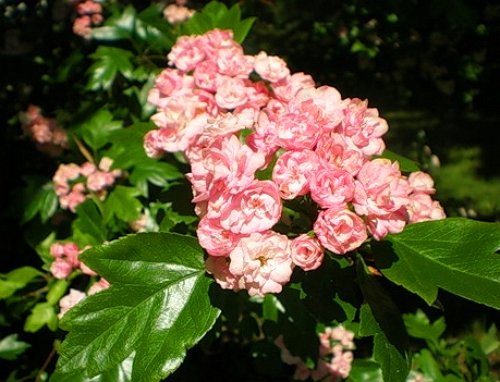Content
Among the large varietal variety of hawthorns, each gardener finds certain preferences for himself. Someone likes decorative varieties, but for someone it is preferable exclusively for nutritional and medicinal value. Hawthorn Toba is a new hybrid plant variety that differs in the color change of flowers during the season.
Breeding history of the variety
Hawthorn Toba bred in Canada, this variety is not included in the State Register. It is becoming popular because it is unpretentious, frost-resistant, perfect for the cold climate of our country.
Since the plant is hybrid, it is grown exclusively by grafting in order to maintain the varietal characteristics in full.
Description of Toba hawthorn
This plant is a tree up to 4 meters high. The crown is thick, has the shape of a ball, looks very beautiful as a decoration of the local area.
This variety, in comparison with many others, has an advantage - there are practically no thorns on the shoots. The leaves are wide, ovoid, dark green on the outside and light on the inside.
In the initial period of flowering, the buds appear white, then the shade changes first to pale pink, then to a rich pink color.
In a hybrid plant, there are no stamens, pistils, and therefore the tree does not bear fruit, only flowers. For lovers of hawthorn jam, the variety is not suitable.
Variety characteristics
According to the description of the Toba hawthorn variety, it belongs to trees that love the sun. It is unpretentious in care, produces a minimum amount of fruits, small in size. It is used in landscape design, more often as a single plant.
Drought resistance and frost resistance
Frost resistance of Toba hawthorn is slightly lower than that of other varieties. In Russia, the hybrid feels great in zone 5a. These regions include: Central Russia, the Baltic states, St. Petersburg, Vladivostok, Minsk, Kiev.
The soil for the normal development of the hybrid must be moderately moist. The plant does not require strong watering, waterlogging. It is enough to water 2 times a month in the absence of rain. In a rainy summer, Toba will do without watering.
Productivity and fruiting
Fruits are formed in small quantities, very rarely. The tree often does not bear fruit. On the site it performs an exclusively decorative function, it pleases the eye with its pink inflorescences. When the flowering period begins, the tree resembles a snow-covered top, the white flowers from the side look like a cap of snow.
Disease and pest resistance
The hybrid variety is more resistant to diseases, fungal and viral infections. It is worth protecting the hawthorn from pests. The hawthorn Toba is affected by the spider mite, leafworm and apple aphid. That is why experts do not recommend planting apple trees, pears and other fruit plants next to the hawthorn. For prevention, it is good to treat the tree with fungicides, and a soap solution or a tobacco mixture is great against pests.
Advantages and disadvantages of the variety
Hawthorn Toba has received positive reviews from amateurs and professionals of decorative decoration. Among the main advantages of the variety:
- lack of thorns;
- beautiful and lush bloom;
- unpretentious care;
- resistance to frost and lack of watering.
But the variety also has disadvantages:
- lack of fruit;
- exactingness to light;
- reproduction only by vaccinations.
Most often, this variety is perfect exclusively for landscape design, since the tree still does not give fruit.
Landing features
Planting hawthorn varieties Toba for the most part does not differ from the standard planting of other varieties of this plant. It is important to choose a sunny outdoor area that will be lit most of the day. It is advisable that there are no tall plants nearby that cast a shadow, since the Toba variety does not tolerate shade and blooms poorly without the sun.
Recommended timing
Grafted seedlings of Toba hawthorn can be planted in autumn or spring. But autumn periods until mid-September during the period of leaf fall are more acceptable. In this case, the seedling will have time to take root before the first frost and in the spring will enter the flowering period with might and main.
Spring terms are optimal before the start of sap flow. It is important that the seedling does not get frozen, otherwise it may die.
Choosing a suitable site and preparing the soil
First of all, you should take into account the fertility of the soil. In order for the Toba hawthorn to take root well and delight the owners with its flowering, it is necessary to dig a hole and properly prepare the soil. The place should first be selected with sufficient lighting, no shade, and also with loose soil. The acidity of the soil should not exceed pH = 8.
The soil must be mixed with humus, peat and it is imperative to make drainage from broken brick or crushed stone at the bottom of the pit. Drainage layer - 15 cm.
What crops can and cannot be planted nearby
Hawthorn Toba is a very light-loving plant that does not tolerate shade for good flowering. Therefore, it should not be planted next to shady and spreading trees, as well as in large group plantings. And also you can not plant a hybrid next to fruit crops that have common pests and diseases: apples, pears, plums, cherries.
If there are beds not far from the hawthorn, then it is good to plant onions and garlic on them, which will scare away aphids from the decorative tree.
Selection and preparation of planting material
Hawthorn Toba belongs to rare varieties, and therefore is distributed only by grafted seedlings. When purchasing such planting material, you must carefully examine it. All roots should be healthy and free of signs of disease, dryness, lethargy or mold. All diseased and defective roots should be removed.
Landing algorithm
The hole should be dug to a depth of 60–80 cm, and the diameter should exceed the volume of the root system. When planting, you need to carefully spread the root system and place the seedling in the center of the planting pit. Sprinkle with earth on top and tamp. The root collar should be flush with the ground. After planting, 15 liters of water should be added under the young plant. The root zone should be mulched about 7 cm with peat. So the plant will take root faster and will not be exposed to freezing.
Follow-up care
Subsequent care after planting consists in watering, feeding, pruning, as well as in properly preparing the tree for wintering, pest and disease control. But it is not difficult to care for the hawthorn.
It is enough to provide watering once a month, even if the summer is dry. This does not apply to young plants that have just been planted. They need to be moistened more often 2-3 times a month. If the weather is rainy, then watering is not needed. Hawthorn does not like too waterlogged soil.
Carry out sanitary and shaping pruning. Sanitary must be carried out after winter, to destroy frostbitten shoots. Dried and diseased shoots can be removed at any time of the year, regardless of the season.
Toba hawthorn is also undemanding for feeding. It is enough to fertilize the tree with cow dung before flowering.
And it is also necessary to loosen the soil cover so that there is more air permeability.
The hawthorn is not required to protect the hawthorn from frost for the winter. The variety is frost-resistant, and only in the northern regions it is necessary to mulch the root zone with straw or hay before winter.
Diseases and pests, methods of control and prevention
There are several methods for fighting disease. The best option is modern complex fungicides, which can be used not only as a therapeutic agent, but also for prophylaxis. It is important to pay attention in time to the appearance of the first symptoms of diseases: spots, dried leaves, twisted leaves, discoloration and early fall of the cover.
Insecticides can be used as pest control, and soap solution is also suitable as a prophylaxis. Experienced gardeners plant insecticidal plants next to hawthorns.
Hawthorn Toba in landscape design
Hawthorn Toba in the photo looks no less magnificent than in life. This ornamental plant feels great both in groups and in single plantings. It can be shaped like a ball, rectangle or pyramid. In plantings in large groups, the Toba hawthorn should be the largest, so as not to lose light.
Alone, it can be used near artificial reservoirs, in the form of curly decorations, near gazebos, as a framing of paths.
Conclusion
Hawthorn Toba is successfully used by professionals in landscape design and novice amateurs. It is only important to remember that the plant needs sunlight and does not tolerate shade. In care, a rare variety of hawthorn is unpretentious, but requires the prevention of diseases and pests. You should not wait for fruiting - this is an exclusively decorative specimen.












